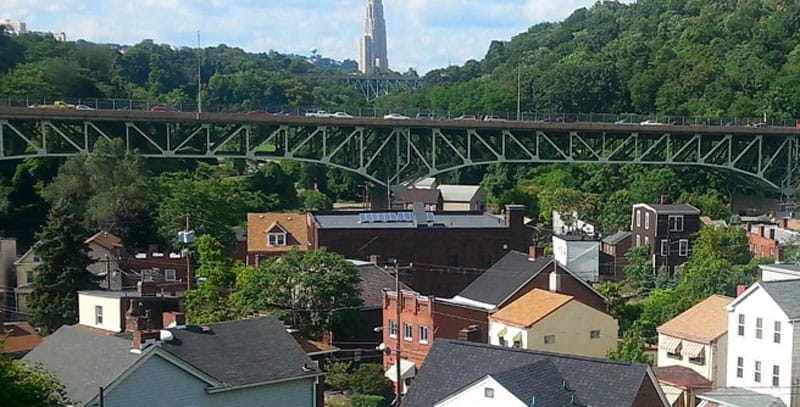If you care about the future of the Junction Hollow Trail, you need to attend this public meeting
The City of Pittsburgh’s Department of Mobility and Infrastructure (DOMI) and the Urban Redevelopment Authority (URA) have been actively seeking to remake the area known as Four Mile Run, the valley and park area between Oakland, Schenley Park, Hazelwood, and Greenfield, with green infrastructure and a new transit connection.
The city has dubbed the project the Mon-Oakland Mobility Plan, and have hosted a series of public meetings to figure this out. First and foremost, the plan looks to deal with the extremely important water runoff and flooding issues endemic to the area.
A second component is a possible transit connection, the case for which the City seems to be struggling to make the case for and define. So far, neither the alignment of the transit connection, the frequency of service, nor the type of transit connection is known to the public. At the January 18 public meeting in Greenfield, the City proposed three options for the service, including an electric autonomous shuttle, electric human-driven shuttle, and a bike share that could include ebikes. Noticeably absent was a proposal exploring a solution that includes the Port Authority using existing roads. It is still unclear who will manage and run the proposed system, but Karina Ricks, the Director of DOMI, has stated that it will be publicly owned.
They also proposed several alignment options for the trail and the proposed transit service. These include an alignment in the existing “Hollow Run,” as well as using new alternatives, such as Bates St, the CSX railroad, Bates St, Juno/Swinburne, and Schenley Park. While options like Bates St were presented as dead on arrival, at the public meeting they asked for input on each of these ideas, which are summarized beginning on slide 33 of their presentation.
February 20: Public Meeting in Hazelwood
According to the City, they have “been reviewing feedback on the alternatives, the priorities that were expressed by each of the neighborhood groups, siting constraints, and the technical aspects of developing an effective connection” since the January 18 public meeting.
They will present their preferred alternative at this public meeting.
Please attend on Tuesday, Feb. 20th to hear about the preferred alternative and continue the discussion about the potential modes of transit along the route. The evening will include an open house for the first hour, a presentation regarding specific elements of the potential route, and an opportunity to provide feedback in small groups.
Meeting Details:
Date: February 20th, 2018
Time: 5-8 PM
Location: Pittsburgh Firefighters Local 1, 120 Flowers Avenue, Pittsburgh, PA 15207
Register for the meeting here.
The City intends to finalize this process in March.
Same concerns
As the project develops, and we learn more about the plan, we remain committed to our original values relating to the possible changes. At the January 18 public meeting, the City acknowledged that not sharing the trail with vehicles is one of many “attributes of a successful connection,” so far nothing we have seen has given us the confidence that they won’t continue to pursue it.
- Improve bicycle facilities, don’t degrade them. The trail must remain separated from motorized vehicles, autonomous or otherwise. Aside from being dangerous, this would set a precedent that would be impossible to retreat from and could threaten other trail corridors. The danger alone is not worth it. Trail users and their families are used to the dynamics of the trail and are not expecting to encounter a motorized vehicle. Throw children into this equation, and we are basically waiting for a tragedy. Those who say that the shuttle will be driving at the same speed as a bike (15mph), have probably never tried to sustain a 15mph pace on a slight hill with children.
- Maintain trail access during construction. This trail is a key mobility corridor for people on bikes, and cannot be closed down. The connection doesn’t need to be fancy, we just need to be able to get through and make sure construction is staged in a way that doesn’t shut people out.
We’d also like to add that we think it’s important for the City to include an option that explores using the Port Authority, and their operators, on existing roads, either with a new or altered service. Whether we can achieve the same transportation benefits, while not disrupting the existing park and neighborhood needs a more serious consideration.
Same Opportunities
The project is happening. While it’s not clear where the transit proposal will lead, the water management component is funded and in the works. There are several opportunities connected to this project that we also need to explore, especially as it could . improve the existing Junction Hollow Trail.
- Panther Hollow Lake Connection. There is a real opportunity to connect the trail to Schenley Park over the train tracks, an improvement that residents have been seeking for a long time. Let’s take advantage of this momentum.
- Light the trail. The Junction Hollow Trail is dark. If there was ever an opportunity to turn this into a 24-hour bicycling connection, it’s this.
- Extend Trail to CMU Parking Lot. There is support for extending the trail to the CMU parking lot, next to Boundary Street. Although narrow, Boundary Street is a popular cycling route, and extending the trail will open up bicycling to many new riders, while making a serious improvement to current ridership.
Sign up for Bike Pittsburgh’s newsletter, The Messenger, to get the latest news on events, bike and pedestrian infrastructure, and fun, delivered straight to your inbox. Twice monthly emails, no spam.


